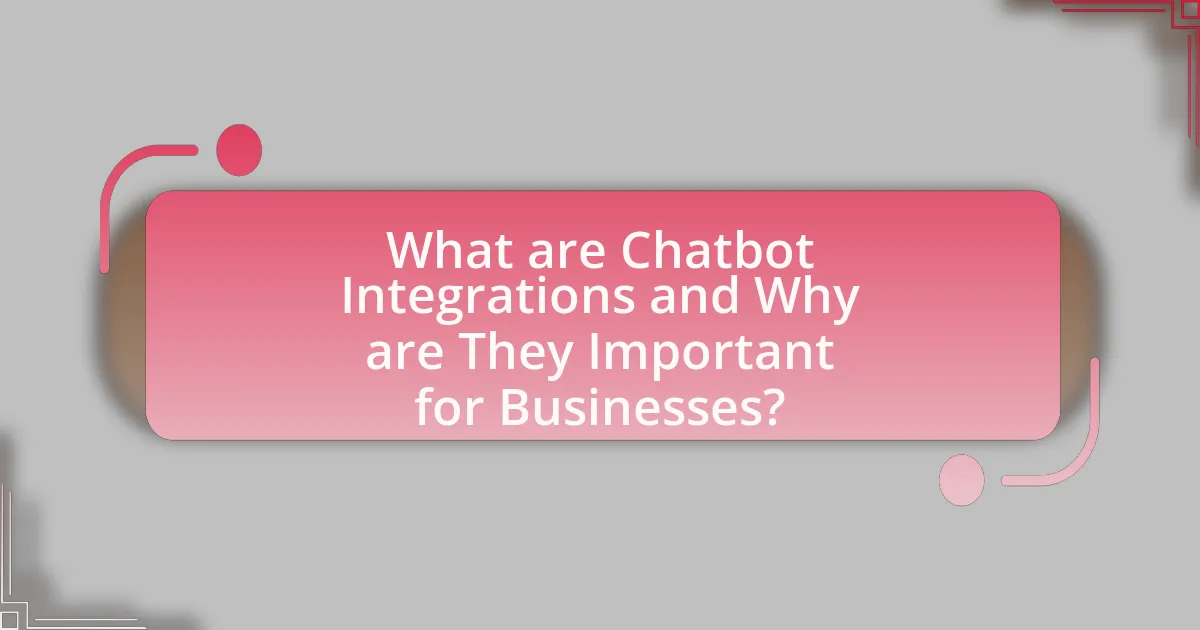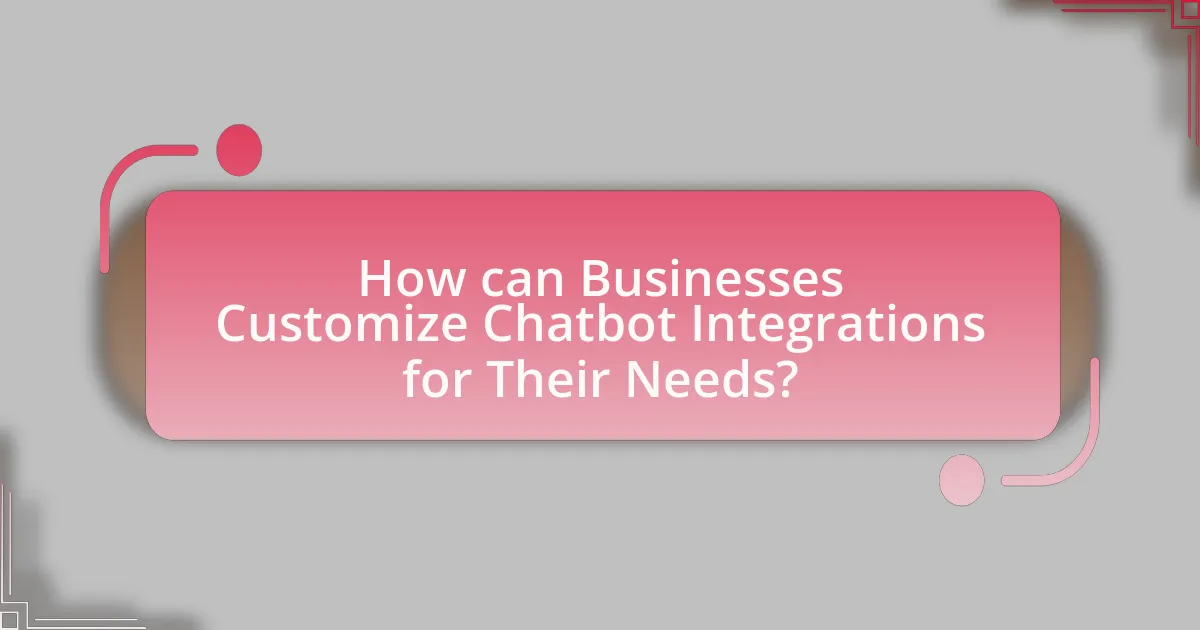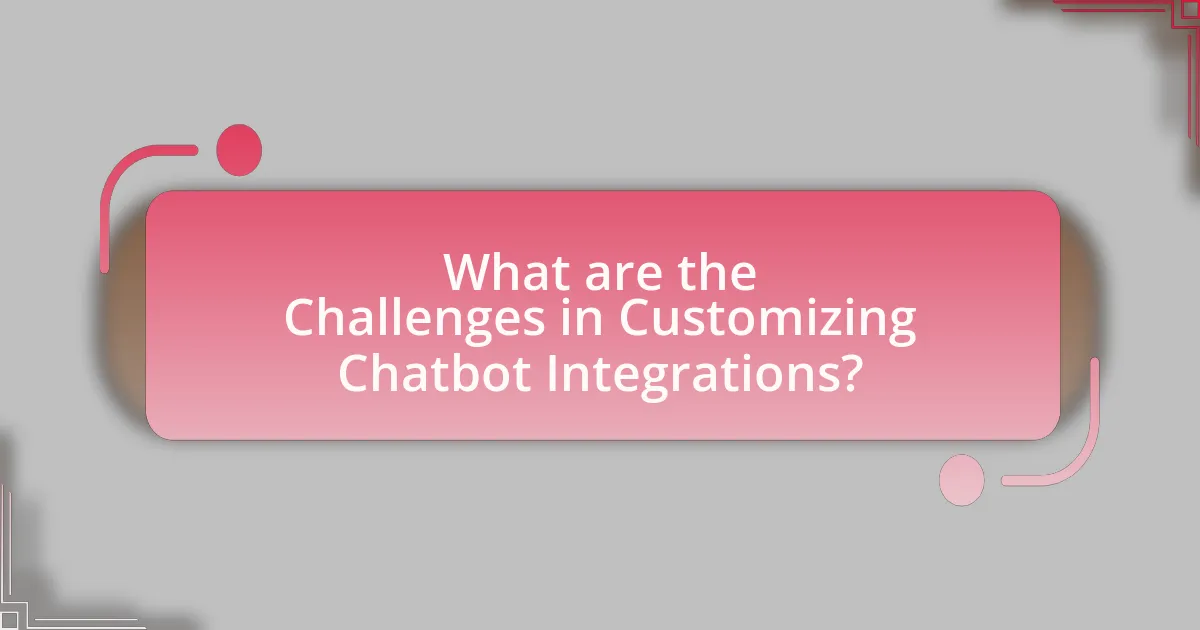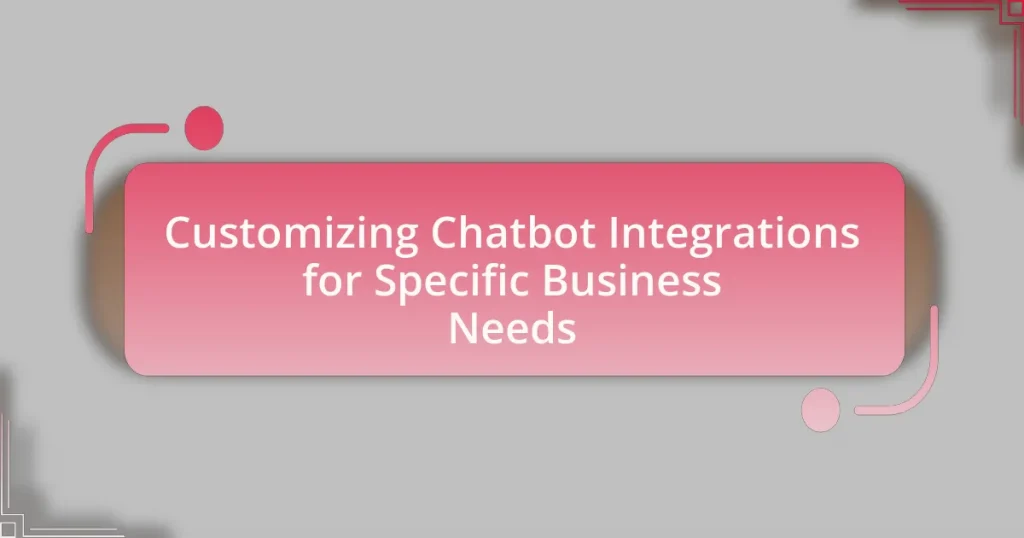The article focuses on customizing chatbot integrations to meet specific business needs, emphasizing their importance for enhancing customer service efficiency and operational effectiveness. It outlines how chatbot integrations facilitate immediate, personalized responses, automate repetitive tasks, and improve response times across various industries, including retail, healthcare, and finance. Key features such as natural language processing, multi-channel support, and analytics capabilities are discussed, along with strategies for overcoming challenges in implementation. The article also highlights the significance of aligning chatbot functionalities with business goals and user expectations to drive customer satisfaction and loyalty.

What are Chatbot Integrations and Why are They Important for Businesses?
Chatbot integrations are the connections that allow chatbots to interact with various software applications and platforms, enabling them to access and utilize data from those systems. These integrations are crucial for businesses because they enhance customer service efficiency, streamline operations, and provide personalized user experiences. For instance, a study by Salesforce found that 69% of consumers prefer chatbots for quick communication with brands, highlighting the importance of integrating chatbots with customer relationship management (CRM) systems to deliver timely and relevant responses. By leveraging chatbot integrations, businesses can automate repetitive tasks, improve response times, and ultimately drive customer satisfaction and loyalty.
How do Chatbot Integrations enhance customer interactions?
Chatbot integrations enhance customer interactions by providing immediate, personalized responses to inquiries, thereby improving customer satisfaction and engagement. These integrations allow businesses to automate responses to frequently asked questions, reducing wait times and ensuring that customers receive timely assistance. For instance, a study by IBM found that chatbots can handle up to 80% of routine inquiries, freeing human agents to focus on more complex issues. Additionally, chatbots can analyze customer data to tailor interactions based on individual preferences, leading to a more customized experience. This capability not only streamlines communication but also fosters a sense of connection between the customer and the brand, ultimately driving loyalty and repeat business.
What features make Chatbot Integrations effective for businesses?
Effective chatbot integrations for businesses include natural language processing, multi-channel support, and analytics capabilities. Natural language processing allows chatbots to understand and respond to customer inquiries in a conversational manner, enhancing user experience and engagement. Multi-channel support enables businesses to deploy chatbots across various platforms, such as websites, social media, and messaging apps, ensuring consistent customer interaction. Analytics capabilities provide insights into customer behavior and preferences, allowing businesses to refine their strategies and improve service delivery. These features collectively contribute to increased efficiency, customer satisfaction, and ultimately, business growth.
How do Chatbot Integrations improve response times and efficiency?
Chatbot integrations improve response times and efficiency by automating interactions and providing instant answers to user inquiries. These systems can handle multiple queries simultaneously, reducing wait times significantly compared to human agents. For instance, a study by IBM found that chatbots can answer up to 80% of routine questions, allowing human staff to focus on more complex issues. This automation not only speeds up response times but also enhances overall operational efficiency by streamlining workflows and reducing the workload on customer service teams.
What types of businesses can benefit from Chatbot Integrations?
Various types of businesses can benefit from chatbot integrations, including e-commerce, customer service, healthcare, and hospitality sectors. E-commerce businesses utilize chatbots for 24/7 customer support, enhancing user experience and increasing sales through personalized recommendations. Customer service departments across industries leverage chatbots to handle inquiries efficiently, reducing response times and operational costs. In healthcare, chatbots assist with appointment scheduling and patient inquiries, improving access to information. The hospitality industry employs chatbots for booking assistance and customer engagement, streamlining operations and enhancing guest experiences. These integrations lead to improved efficiency, customer satisfaction, and cost savings across these sectors.
Which industries are leading in adopting Chatbot Integrations?
The industries leading in adopting chatbot integrations are primarily retail, healthcare, finance, and customer service. Retailers utilize chatbots for personalized shopping experiences and customer support, with 67% of consumers reporting a positive experience when interacting with chatbots. In healthcare, chatbots assist in patient scheduling and symptom checking, enhancing operational efficiency. The finance sector employs chatbots for transaction inquiries and fraud detection, improving customer engagement and security. Customer service across various sectors leverages chatbots to handle inquiries and provide 24/7 support, significantly reducing response times and operational costs.
How do business sizes influence the need for Chatbot Integrations?
Business sizes significantly influence the need for chatbot integrations, as larger organizations typically require more complex and scalable solutions to manage higher volumes of customer interactions. For instance, a study by Gartner indicates that enterprises with over 1,000 employees often implement chatbots to streamline customer service and reduce operational costs, with 70% of these businesses reporting improved efficiency. In contrast, small businesses may prioritize simpler, cost-effective chatbot solutions to enhance customer engagement without the need for extensive resources. This differentiation in requirements highlights how the scale of operations directly impacts the complexity and functionality of chatbot integrations needed to meet specific business objectives.

How can Businesses Customize Chatbot Integrations for Their Needs?
Businesses can customize chatbot integrations by leveraging APIs, defining specific user intents, and utilizing machine learning algorithms tailored to their operational requirements. By integrating APIs, businesses can connect chatbots to existing systems such as CRM or ERP, enabling seamless data exchange and functionality. Defining user intents allows businesses to create tailored conversational flows that address specific customer queries and enhance user experience. Additionally, employing machine learning algorithms enables chatbots to learn from interactions, improving their responses over time based on user behavior and preferences. This approach has been validated by numerous case studies, such as those from companies like Zendesk, which reported a 30% increase in customer satisfaction through customized chatbot solutions.
What are the key customization options available for Chatbot Integrations?
Key customization options for chatbot integrations include personalized conversation flows, user interface design, integration with third-party applications, and natural language processing capabilities. Personalized conversation flows allow businesses to tailor interactions based on user data and preferences, enhancing user engagement. User interface design customization enables brands to align the chatbot’s appearance with their visual identity, improving brand consistency. Integration with third-party applications, such as CRM systems or payment gateways, facilitates seamless operations and data exchange. Finally, advanced natural language processing capabilities can be customized to understand specific industry jargon or user intents, ensuring more accurate responses. These options collectively enhance the effectiveness and relevance of chatbot integrations for specific business needs.
How can businesses tailor conversation flows to their specific requirements?
Businesses can tailor conversation flows to their specific requirements by analyzing customer interactions and defining clear objectives for their chatbots. By utilizing data analytics, businesses can identify common queries and pain points, allowing them to design conversation flows that address these specific needs effectively. For instance, a retail company may implement a flow that prioritizes product inquiries and order tracking, while a service provider might focus on troubleshooting and appointment scheduling. This targeted approach enhances user experience and increases engagement, as evidenced by a study from the Harvard Business Review, which found that personalized interactions can lead to a 20% increase in customer satisfaction.
What role does branding play in customizing Chatbot Integrations?
Branding plays a crucial role in customizing chatbot integrations by ensuring that the chatbot reflects the company’s identity and values. This alignment enhances user experience and fosters brand recognition, as a well-branded chatbot can communicate in a tone and style consistent with the company’s messaging. For instance, a study by HubSpot found that 70% of consumers prefer to engage with brands that have a consistent identity across all platforms, including chatbots. Therefore, effective branding in chatbot customization not only improves customer interaction but also strengthens brand loyalty and trust.
How can businesses ensure their Chatbot Integrations align with customer expectations?
Businesses can ensure their chatbot integrations align with customer expectations by conducting thorough user research and continuously gathering feedback. Understanding customer needs through surveys, interviews, and usage analytics allows businesses to tailor chatbot functionalities and responses effectively. For instance, a study by Salesforce found that 69% of consumers prefer chatbots for quick communication with brands, highlighting the importance of responsiveness and relevance in chatbot interactions. By regularly updating the chatbot based on customer feedback and performance metrics, businesses can enhance user satisfaction and ensure that the chatbot meets evolving expectations.
What methods can be used to gather customer feedback on Chatbot performance?
Surveys and feedback forms are effective methods to gather customer feedback on chatbot performance. These tools can be integrated into the chatbot interface, allowing users to rate their experience immediately after interaction. Research indicates that 70% of customers prefer providing feedback through short surveys, which can include multiple-choice questions or open-ended responses to capture detailed insights. Additionally, monitoring user interactions and analyzing conversation logs can reveal patterns in customer satisfaction and areas for improvement, as data-driven insights often lead to more targeted enhancements in chatbot functionality.
How can businesses analyze customer interactions to improve Chatbot effectiveness?
Businesses can analyze customer interactions by utilizing data analytics tools to track conversation patterns, customer feedback, and engagement metrics. By examining these interactions, businesses can identify common queries, pain points, and user satisfaction levels, which directly inform chatbot training and optimization. For instance, a study by Salesforce found that 69% of customers prefer chatbots for quick communication, highlighting the importance of effective interaction analysis. This data allows businesses to refine chatbot responses, enhance user experience, and ultimately improve effectiveness in addressing customer needs.

What are the Challenges in Customizing Chatbot Integrations?
Customizing chatbot integrations presents several challenges, including technical complexity, data compatibility, and user experience design. Technical complexity arises from the need to integrate various APIs and platforms, which can lead to compatibility issues and increased development time. Data compatibility challenges occur when existing systems do not align with the chatbot’s data requirements, necessitating additional data transformation or migration efforts. Furthermore, ensuring a seamless user experience requires careful design to meet specific business needs while maintaining intuitive interactions, which can be difficult to achieve without extensive user testing and feedback.
What common obstacles do businesses face when implementing Chatbot Integrations?
Businesses commonly face several obstacles when implementing chatbot integrations, including technical challenges, lack of clear objectives, and insufficient user training. Technical challenges often arise from integrating chatbots with existing systems, which can lead to compatibility issues and increased development time. A lack of clear objectives can result in poorly defined use cases, making it difficult to measure success and ROI. Additionally, insufficient user training can hinder the effective use of chatbots, as employees may not fully understand how to leverage the technology for optimal customer interaction. These obstacles can significantly impact the overall effectiveness and adoption of chatbot solutions within organizations.
How can technical limitations hinder Chatbot customization?
Technical limitations can significantly hinder chatbot customization by restricting the ability to modify functionalities and integrate with other systems. For instance, if a chatbot platform lacks APIs or has limited access to third-party services, businesses cannot tailor the chatbot to meet specific operational requirements. Additionally, constraints in natural language processing capabilities may prevent the chatbot from understanding and responding accurately to user queries, thereby reducing its effectiveness. According to a report by Gartner, 70% of organizations cite integration challenges as a primary barrier to effective chatbot deployment, highlighting the impact of technical limitations on customization efforts.
What are the risks of not aligning Chatbot Integrations with business goals?
Not aligning chatbot integrations with business goals can lead to inefficiencies, wasted resources, and missed opportunities. When chatbots operate independently of strategic objectives, they may fail to address customer needs effectively, resulting in poor user experiences and decreased customer satisfaction. For instance, a study by Gartner indicates that organizations that align technology initiatives with business goals are 50% more likely to achieve their desired outcomes. Additionally, misalignment can lead to increased operational costs, as resources are spent on features that do not contribute to the overall mission, ultimately hindering growth and competitive advantage.
How can businesses overcome these challenges effectively?
Businesses can effectively overcome challenges in customizing chatbot integrations by adopting a structured approach that includes thorough needs assessment, iterative development, and continuous feedback loops. Conducting a comprehensive needs assessment allows businesses to identify specific requirements and pain points, ensuring that the chatbot is tailored to meet user expectations. Iterative development, which involves creating prototypes and refining them based on user interactions, helps in addressing unforeseen issues early in the process. Continuous feedback loops, where businesses gather insights from users and stakeholders, facilitate ongoing improvements and adjustments to the chatbot’s functionality. Research indicates that companies that implement user-centered design principles in chatbot development see a 30% increase in user satisfaction and engagement, demonstrating the effectiveness of these strategies.
What strategies can be employed to ensure successful Chatbot Integration?
To ensure successful chatbot integration, businesses should adopt a multi-faceted approach that includes defining clear objectives, selecting the right technology, and ensuring seamless user experience. Clear objectives guide the development process, allowing teams to focus on specific functionalities that meet user needs. Choosing the right technology involves evaluating platforms that support necessary features, such as natural language processing and analytics, which are crucial for effective communication and performance tracking. Additionally, a seamless user experience can be achieved by designing intuitive interfaces and providing comprehensive training for users, which enhances engagement and satisfaction. Research indicates that companies that prioritize these strategies see a 30% increase in user adoption rates, demonstrating the effectiveness of a structured integration approach.
How can ongoing training and updates improve Chatbot performance?
Ongoing training and updates significantly enhance chatbot performance by ensuring the system remains current with user expectations and language trends. Continuous learning allows chatbots to adapt to new phrases, slang, and context, improving their understanding and response accuracy. For instance, a study by Microsoft found that regular updates can increase a chatbot’s accuracy by up to 30%, as it learns from new interactions and feedback. This iterative process not only refines the chatbot’s ability to handle diverse queries but also boosts user satisfaction and engagement, leading to more effective customer interactions.
What are the Best Practices for Customizing Chatbot Integrations?
The best practices for customizing chatbot integrations include defining clear objectives, understanding user needs, ensuring seamless API connectivity, and maintaining a consistent brand voice. Defining clear objectives helps in aligning the chatbot’s functionality with business goals, while understanding user needs allows for tailored interactions that enhance user experience. Seamless API connectivity is crucial for integrating the chatbot with existing systems, ensuring data flow and operational efficiency. Maintaining a consistent brand voice across all interactions reinforces brand identity and fosters trust. These practices are supported by industry findings, such as a report from Gartner, which states that organizations that prioritize user experience in chatbot design see a 20% increase in customer satisfaction.
How can businesses prioritize features based on user needs?
Businesses can prioritize features based on user needs by employing user feedback mechanisms, such as surveys and interviews, to gather insights directly from their target audience. This approach allows businesses to identify which features are most desired and necessary for enhancing user experience. For instance, a study by the Nielsen Norman Group found that user-centered design, which incorporates user feedback, leads to a 50% increase in user satisfaction. By analyzing this data, businesses can rank features based on frequency of requests and overall impact on user engagement, ensuring that development resources are allocated effectively to meet user expectations.
What role does continuous testing play in optimizing Chatbot Integrations?
Continuous testing is essential for optimizing chatbot integrations as it ensures consistent performance, reliability, and user satisfaction. By regularly evaluating the chatbot’s functionality and interactions, businesses can identify and rectify issues promptly, leading to improved user experiences. For instance, a study by Capgemini found that organizations implementing continuous testing in their chatbot development process experienced a 30% reduction in deployment time and a 25% increase in user engagement. This data underscores the importance of continuous testing in refining chatbot capabilities to meet specific business needs effectively.
What are the Future Trends in Chatbot Customization?
Future trends in chatbot customization include increased personalization through advanced AI algorithms, integration with multiple platforms for seamless user experiences, and enhanced natural language processing capabilities. These trends are driven by the growing demand for tailored customer interactions, as businesses seek to improve engagement and satisfaction. For instance, a report by Gartner indicates that by 2025, 75% of customer service interactions will be powered by AI, highlighting the shift towards more intelligent and adaptable chatbot solutions. Additionally, the rise of no-code platforms is enabling businesses to customize chatbots without extensive technical expertise, further accelerating the trend towards personalized and efficient chatbot integrations.
How is AI influencing the future of Chatbot Integrations?
AI is significantly influencing the future of chatbot integrations by enhancing their ability to understand and respond to user queries with greater accuracy and personalization. Advanced natural language processing (NLP) algorithms enable chatbots to interpret context, sentiment, and intent, allowing for more meaningful interactions. For instance, a study by Gartner predicts that by 2025, 75% of customer service interactions will be powered by AI, demonstrating the growing reliance on AI-driven solutions for effective communication. This shift not only improves user experience but also allows businesses to customize chatbot functionalities to meet specific operational needs, thereby increasing efficiency and customer satisfaction.
What emerging technologies should businesses consider for Chatbot enhancements?
Businesses should consider artificial intelligence advancements, natural language processing improvements, and machine learning algorithms for chatbot enhancements. These technologies enable chatbots to understand and respond to user queries more accurately, providing a more personalized experience. For instance, AI-driven chatbots can analyze user behavior and preferences, leading to tailored interactions that increase customer satisfaction. Additionally, advancements in natural language processing, such as transformer models, enhance a chatbot’s ability to comprehend context and nuances in human language, resulting in more effective communication. Machine learning algorithms allow chatbots to learn from past interactions, continuously improving their performance over time.
What Practical Tips Can Help Businesses Customize Chatbot Integrations Successfully?
To successfully customize chatbot integrations, businesses should focus on defining clear objectives and understanding user needs. Establishing specific goals allows businesses to tailor the chatbot’s functionalities to meet customer expectations effectively. For instance, a study by Salesforce found that 69% of consumers prefer chatbots for quick communication with brands, highlighting the importance of aligning chatbot capabilities with user preferences. Additionally, businesses should leverage analytics to monitor interactions and continuously refine the chatbot’s responses, ensuring it evolves based on real user feedback. This data-driven approach enhances the chatbot’s relevance and effectiveness in addressing customer inquiries.










